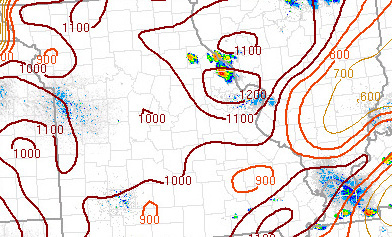
The down draft is the air that rushes out of a thunderstorm and to the ground. Once it gets the ground, it fans out in all directions similar to a water balloon breaking when hitting the ground. These down drafts are what are responsible for causing convective wind gusts. Another term used is “straight line wind” in order to discern it from the rotational winds of a tornado. Just like tornadoes, straight line wind can have a variety of different wind speeds although straight line wind generally has a weaker wind than a moderate or strong tornado. Straight line wind is severe when the wind speed exceeds 50 knots (58 mph). These speeds can cause damage to fencing, houses and objects vulnerable to the wind. Down Draft CAPE is an index that helps give the forecaster an idea of how strong convective wind gusts will be. Several of the actual physical variables that help produce a stronger down draft include: 1) a higher CAPE (more instability) 2) dry air in mid-levels (~700 to ~500 mb) (evaporative cooling supports negative buoyancy which causes the air to sink faster to the surface 3) supercell storm or linear band of severe storms (energy is focused into one region or along a single axis allowing for plenty of potential energy to be converted into storm kinetic energy) 4) Warm air in the boundary layer (the contrast in air density between the heavy colder air and lighter warm air will allow for a more intense down draft The image below shows an example of down draft CAPE. The higher the value then the greater the potential for a stronger downdraft. There can be significant errors in the values of down draft CAPE due to spatial resolution of actual observations and contamination from air mixing in the boundary layer but it gives the forecaster a general idea if stronger down drafts can be expected. Values below 600 and especially closer to zero are associated with weaker down drafts and values over 1,000 and especially over 1,500 are associated with very strong down drafts. This is a generality since any storm is capable of producing severe convective wind gusts given the right set of conditions.  |